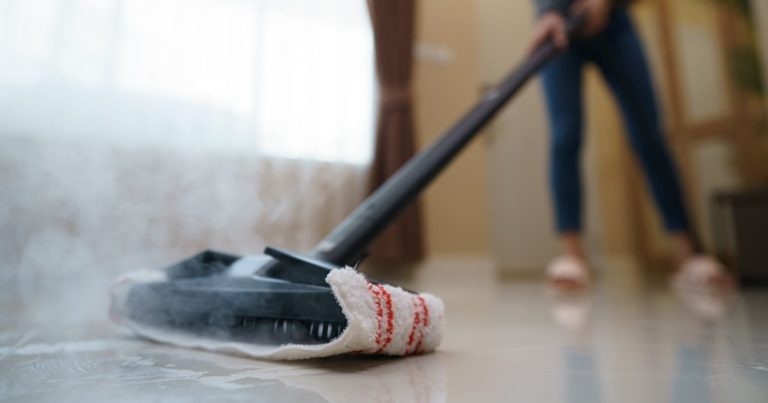How to Clean Stamped Concrete
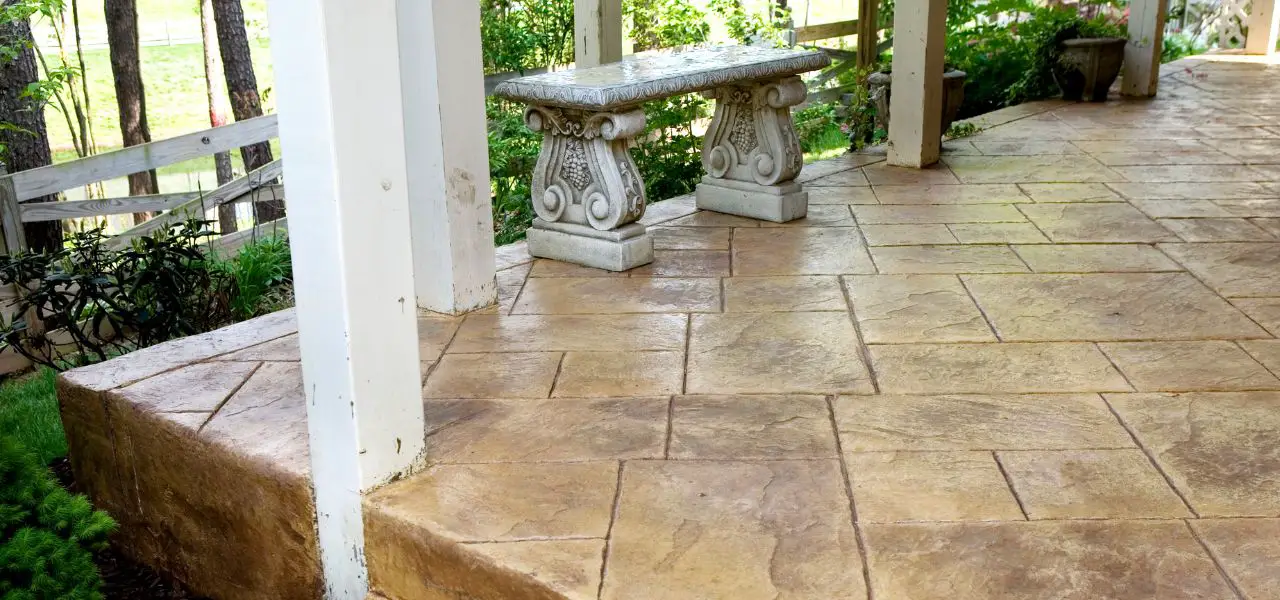
Stamped concrete can withstand harsh weather and last decades when properly installed and maintained. Color hardeners used in stamping make the surface smoother and more resistant to abrasion and water penetration.
Contractors apply protective sealer coats to prevent dirt, chemicals, oil, grease, and other substances from penetrating and protect against UV damage.
However, stamped concrete may still require routine maintenance depending on weather conditions and traffic.
To clean and maintain exterior and interior surfaces, it is important to immediately remove spills, oil, grease, or other damaging substances. Sealers help prevent stains, but prompt removal of these substances is still necessary.
Here are some tips and advice on how to clean stamped concrete.
How to Clean Indoor Stamped Concrete
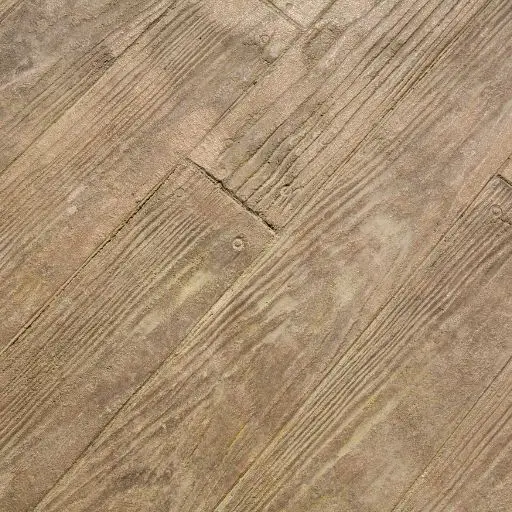
Stamped concrete is a popular choice for indoor flooring due to its durability and aesthetic appeal. However, like any other flooring material, it requires regular cleaning to maintain its appearance and longevity.
Here are some tips on how to clean indoor stamped concrete:
Use a Mild Cleaning Solution
When cleaning indoor stamped concrete, using a mild cleaning solution that won’t damage the surface is essential. Avoid harsh chemicals or acidic cleaners, which can discolor or etch your floor.
Instead, opt for a pH-neutral cleaner specifically designed for decorative concrete.
Mix the cleaning agent with water according to the manufacturer’s instructions. Mop your concrete floor as you would any other floor. Allow it to air dry.
Sweep or Vacuum Regularly
Regularly sweeping or vacuuming your indoor stamped concrete helps prevent dirt buildup that can scratch or damage the surface over time. Use a soft-bristled broom or vacuum with a hard floor attachment to remove dust particles.
If you notice any spills or stains on your floor, clean them up immediately using a damp cloth or mop. Don’t let them sit for too long, as they can penetrate the porous surface of the concrete and become more difficult to remove.
Avoid Abrasive Tools
Avoid using abrasive tools such as steel wool pads, wire brushes, or pressure washers when cleaning your indoor floors. These tools can scratch or damage the surface of your concrete, leaving unsightly marks that are difficult to repair.
Instead, use gentle cleaning tools such as a push broom, soft-bristled brushes, or microfiber mops when cleaning your floors. Use a non-abrasive nylon scrub pad instead of steel wool for extra scrubbing power.
If you want to use a steam mop for concrete, always use a low heat and steam setting.
How to Clean Outdoor Stamped Concrete
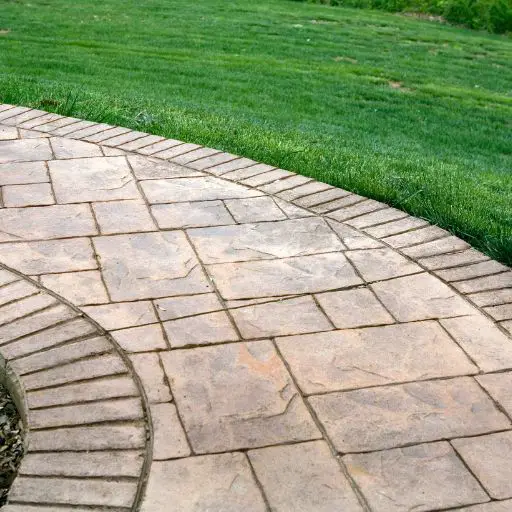
Stamped concrete is popular for outdoor patios, walkways, and driveways. It adds an elegant touch to any home’s exterior while providing a durable surface that can withstand heavy foot traffic and weather conditions.
However, like any other outdoor surface, stamped concrete can accumulate dirt, grime, and stains over time. Cleaning it regularly keeps it looking its best and extends its lifespan.
Use a Pressure Washer to Remove Dirt and Grime
Using a broom or leaf blower, the first step in cleaning outdoor stamped concrete is removing loose debris, such as leaves and twigs.
Next, use a pressure washer with at least 3,000 PSI to blast away dirt and grime from the surface of the concrete. A pressure washer can also assist in removing stubborn stains such as oil spills or tire marks.
When using a pressure washer on stamped concrete, keep the nozzle at least 12 inches from the surface to avoid damaging it. Start at one end of the area you’re cleaning and work your way across in even strokes.
Apply a Concrete Cleaner Solution and Scrub with a Stiff-Bristled Brush
After using the pressure washer, apply a concrete cleaner solution to the surface of the stamped concrete.
Many commercial agents are available on the market specifically designed for cleaning concrete surfaces. Some popular options include:
- Simple Green Concrete and Driveway Cleaner
- Zep Driveway and Concrete Cleaner for sealed concrete
- Krud Kutter Concrete and Driveway Pressure Washer Concentrate
Wear gloves and eye protection when using these products.
Using a stiff-bristled brush (avoid wire brushes), scrub the cleaning agent into the surface of the stamped concrete thoroughly. Pay special attention to areas with tough stains or high-traffic areas where dirt accumulates.
If your concrete is in bad shape and you need to strip it back and etch it before completely resealing, try Concrete Coatings Etch, Clean and Degrease. It also works to remove rust.
Rinse Thoroughly With Water and Allow it to Dry Completely Before Sealing
Once you’ve scrubbed all areas with a cleaner solution, rinse off all residue completely with water using your garden hose or pressure wash again if necessary.
Remove all traces of the cleaner solution, as any remaining residue can cause discoloration or damage to the surface.
After rinsing, allow the stamped concrete to dry completely before sealing it. This usually takes around 24-48 hours, depending on your area’s weather conditions and humidity levels.
Live in a Cold Region? Avoid cleaning during Winter thaw cycles
It is important to avoid cleaning your stamped concrete during thaw cycles when temperatures fluctuate between freezing and above-freezing levels.
This can cause water buildup beneath your patio or driveway, leading to cracks forming over time due to expansion/contraction caused by temperature changes.
What to do if Your Concrete Has Rust
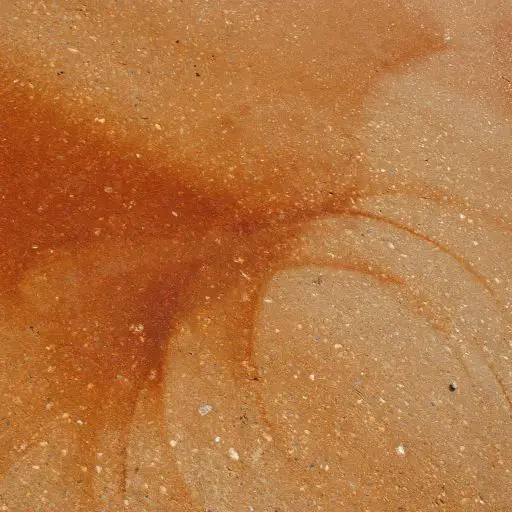
Oxalic acid is an organic acid that reacts with iron oxide (rust) to dissolve it.
Here’s how you would use oxalic acid to clean a rust stain on stamped concrete:
- Safety first: Before starting, always wear safety goggles, gloves, and protective clothing, as oxalic acid can be harmful if it comes into contact with your skin or eyes. Ensure the area is well-ventilated.
- Prepare the solution: Mix a solution of acid and water, following the manufacturer’s instructions for the correct proportions. Typically, you’ll mix about one cup of oxalic acid with a gallon of water.
- Apply the solution: Pour the solution onto the rust stain and let it sit for about 15-20 minutes. Do not let the solution dry out – if it starts to, add more solution.
- Scrub: Use a scrub brush to work the solution into the stain. Scrub vigorously to help the acid penetrate the rust.
- Rinse: After scrubbing, thoroughly rinse the area with water. Ensure all the acid is washed away, as any residue can continue to react with the concrete.
- Repeat if necessary: If the rust stain is still visible, you may need to repeat the process.
- Neutralize: After removing the rust, neutralize the area with baking soda and water, then rinse it again.
- Dry: Let the concrete dry completely.
It’s important to note that while oxalic acid effectively removes rust stains, it should be used cautiously. It’s always a good idea to test the solution on a small, hidden area, particularly if you have colored concrete. Always follow the manufacturer’s instructions and safety guidelines.
Best Ways to Clean Stamped Concrete: Tips and Tricks
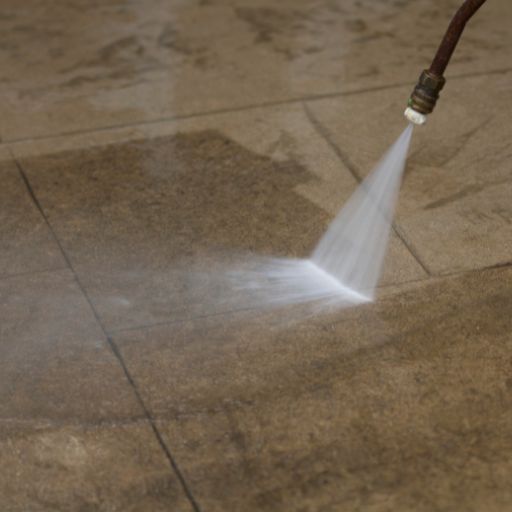
Sweep Regularly
Sweeping your stamped concrete regularly can help prevent the buildup of dirt and dust on its surface. This simple task helps keep your patio looking great all year round while reducing cleaning frequency.
To sweep your stamped concrete:
- Use a stiff-bristled push broom or brush designed specifically for outdoor surfaces.
- Begin at one end of the surface and work your way across in sections.
- Sweep in straight lines or circular motions, depending on what works best for you.
- Be sure to sweep up any leaves or other plant debris that may have accumulated on your patio’s surface.
Avoid Using Acidic Cleaners
Acidic cleaners such as vinegar or lemon juice can harm concrete. These products can cause discoloration and damage to the surface, leading to costly repairs.
Instead, use a mild detergent or soap solution mixed with warm water. This solution is gentle enough not to harm your stamped concrete but strong enough to remove dirt and stains effectively.
Apply a Sealant After Cleaning
After cleaning your concrete, applying a sealer is recommended. A quality sealant helps protect the surface from future stains and damage caused by exposure to the elements.
Some sealants add a glossy finish to the surface, making it look more polished.
When choosing a sealer for your stamped concrete surface, consider factors such as durability, UV resistance, and water repellency.
Different types are available today; however, experts recommend a penetrating repellent sealer over film-forming ones as they offer better protection against moisture damage. A repellent sealer is more durable, long-lasting, and requires less maintenance than film-forming sealers.
To apply a sealer:
- Wait for your surface to dry completely after cleaning.
- Choose a penetrating sealant designed specifically for concrete surfaces.
- Apply the sealant evenly using a roller or sprayer.
- Allow the sealant to dry according to the manufacturer’s instructions.
Benefits of Concrete Maintenance and Sealing
Stamped concrete is popular for patios, driveways, walkways, and other outdoor surfaces. It provides an attractive and durable surface that can mimic the look of natural stone or brick.
However, like any other outdoor surface, stamped concrete can become dirty or damaged over time. That’s why it’s essential to seal and maintain these surfaces regularly.
Applying a quality sealant can enhance the appearance of stamped surfaces.
One of the most significant benefits of sealing stamped concrete is that it enhances its appearance. A high-quality water repellant sealer can bring out the colors in the concrete and make them more vibrant.
Sealers protect surfaces from damage caused by weather and foot traffic.
Another benefit of sealing stamped concrete is that it protects the surface from damage caused by weather conditions such as rain, snow, and extreme heat. Over time, exposure to these elements can cause cracks or fading in the surface.
Sealing also protects against damage caused by foot traffic. Areas with high foot traffic are particularly susceptible to wear and tear over time. Sealing these areas can improve adhesion between the surface and footwear while preventing damage from occurring.
Maintaining the original sealer can extend the life of the surface.
Maintaining your sealed area also involves resealing every few years as needed depending on how much traffic or weathering the surface has undergone since its last sealant application. This will help ensure that your stamped concrete remains protected against damage caused by weather and foot traffic.
Sealing areas with high foot traffic can improve adhesion and prevent damage.
As mentioned earlier, sealing areas with high foot traffic is essential for preventing damage to the surface. However, it’s also important to note that sealing these areas can improve adhesion between the surface and footwear, making it safer for people to walk on.
When choosing a sealer for high-traffic areas, consider one that has a non-slip additive added to it. This will help prevent slips and falls on wet surfaces.
Resealing surfaces can reduce the amount of maintenance required.
Resealing your stamped concrete regularly is crucial to maintain its appearance and protect it from damage caused by exposure to the elements. Over time, the sealer on your stamped concrete will wear off due to foot traffic, weather conditions, and other factors. When that happens, you need to apply a fresh coat of sealer to restore its protective properties.
If you’re unsure whether your stamped concrete needs resealing, you can do a simple test at home.
Pour a small amount of water onto the surface of your stamped concrete and observe how quickly it gets absorbed. If the water beads up on the surface or takes several minutes to absorb, your sealer is still intact.
However, it’s time to reseal if the water gets absorbed within seconds or leaves a dark spot on the surface.
Apply the Sealer in Thin Coats
When applying a sealer to your stamped concrete surface, it’s essential to follow the manufacturer’s instructions carefully. Applying too much sealer can cause it to puddle or form bubbles on the surface, leading to an uneven finish.
Instead, apply the sealer in thin coats using a sprayer or roller.
Start by cleaning your stamped concrete thoroughly using a power washer or hose and letting it dry completely before applying the sealer. Then, pour the sealer into a pump sprayer and spray it evenly over the surface of your stamped concrete. Use a roller to smooth out any puddles or bubbles that may form during application.
Removing tough stains from stamped concrete
Stamped concrete is popular for patios, driveways, and walkways due to its durability and aesthetic appeal. However, over time, it can accumulate tough stains that are difficult to remove.
How to Remove Oil Stains from Stamped Concrete
A decorative concrete driveway is a popular choice for many suburban homes. But what happens if a car drips oils on this? Not only are oil stains unsightly, but they can also damage the decorative concrete if left untreated.
Immediate Action is Necessary
When you notice an oil stain on your stamped concrete, it’s important to immediately prevent it from penetrating the surface. The longer you wait, the more difficult it will be to remove the stain. Here are some steps you can take:
- Use absorbent materials like kitty litter or baking soda to soak excess oil.
- Cover the area with absorbent material and let it sit for several hours or overnight.
- Sweep up the absorbent material and dispose of it properly.
Using Degreasers
If there is still noticeable staining after using absorbent materials, you may need to use a degreaser specifically designed for removing oil stains and concrete cleaning. Here’s how:
- Choose a high-quality degreaser that is safe for concrete cleaning.
- Dilute the degreaser according to the manufacturer’s instructions in a bucket of warm water.
- Apply the solution to the stained area using a scrub brush or mop.
- Let it sit for 10-15 minutes before scrubbing again with a stiff-bristled brush.
- Rinse thoroughly with clean water.
Dish Soap Mixture
If you don’t have access to a degreaser or prefer not to use one, dish soap mixed with warm water can also effectively remove oil stains from stamp concrete.
- Mix one tablespoon of dish soap with two cups of warm water in a bucket. (You could also try laundry detergent).
- Apply the solution to the stained area using a scrub brush or mop.
- Let it sit for 10-15 minutes before scrubbing again with a stiff-bristled brush.
- Rinse thoroughly with clean water.
Keeping your stamped concrete looking like new
In conclusion, cleaning and maintaining your stamped concrete is essential to keep it looking like new. Whether it’s indoor or outdoor stamped concrete, following the step-by-step instructions for cleaning can help remove tough stains and keep it in top condition.
Sealing and maintaining the surface will also provide numerous benefits, such as protection from weather damage and prolonging its lifespan.
To ensure that you’re taking good care of your stamped concrete, here are some FAQs to consider:
FAQs
Q: How often should I clean my stamped concrete?
A: It’s recommended to clean your stamped concrete at least once a year to prevent dirt buildup and maintain its appearance.
Q: Can I use bleach to clean my stamped concrete?
A: While bleach can effectively remove stains, it’s not recommended as it can damage the surface. Instead, use a pH-neutral cleaning solution suitable for concrete surfaces.
Q: Do I need to reseal my stamped concrete after cleaning?
A: It’s important to reseal your stamped concrete every 2-3 years or as needed after cleaning to protect the surface from damage.
Q: How do I remove rust stains from my stamped concrete?
A: Rust stains can be difficult to remove but using a rust remover designed for outdoor surfaces can help.
Q: Can pressure washing damage my stamped concrete?
A: Yes, using too much pressure when pressure washing can damage the surface of your stamped concrete. Be sure to follow manufacturer guidelines or hire a professional cleaner.
By following these tips and answering common questions about cleaning and maintaining your stamped concrete, you’ll be able to keep it looking great for years to come!
- Can You Use a Steam Mop On Karndean Flooring? - June 19, 2024
- How To Clean Unsealed Concrete Floors - June 7, 2024
- How to Clean Stamped Concrete - June 7, 2024






